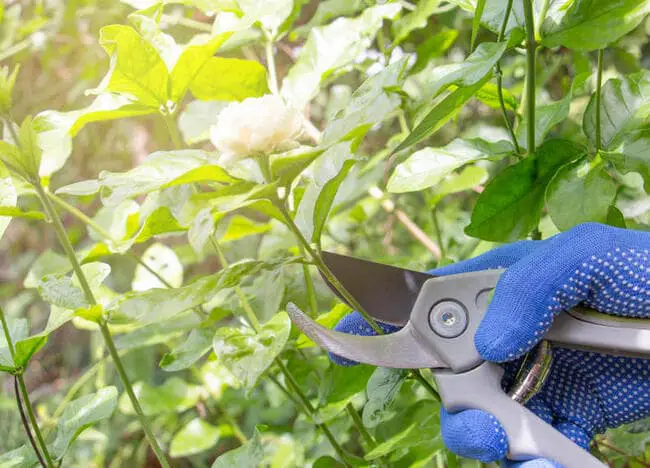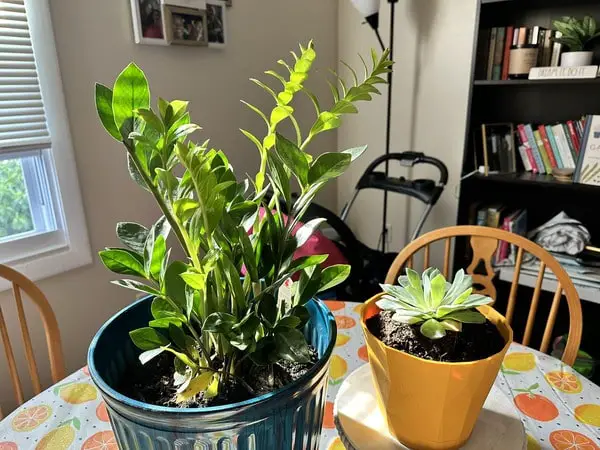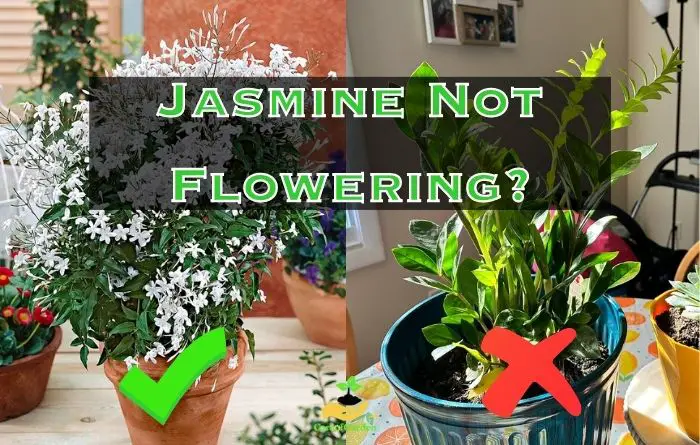Jasmine Not Flowering: 7 Surprising Reasons & What To Do!
Hello, plant lovers! If you’re one of those passionate gardeners like me who loves the sweet scent of jasmine but has noticed that it doesn’t bloom, don’t worry! In this blog post, we’ll explore some of the most common reasons why your jasmine is not flowering and give you some tips on how to fix these issues.
Jasmine plants do not flower for several reasons, including lack of sunlight, improper fertilization, low temperatures, and pruning at the wrong time. Additionally, young jasmine plants may need time to establish their root system and overall growth before they start producing blooms. If your jasmine plant is not blooming, make sure it’s getting enough sunlight and the right nutrients.
Reasons Jasmine is Not Flowering:
1. Pruning Mistakes

Pruning your jasmine plant incorrectly can prevent it from blooming. There are a few common mistakes to avoid:
The first mistake is pruning at the wrong time. Jasmine has a specific pruning time frame, and if you don’t respect it, it can disrupt the plant’s natural growth cycle.
For example, pruning during or too close to the flowering period can result in reduced flower production or no flowers at all. Prune in autumn to avoid removing young shoots and unintentionally prevent flowering.
The second mistake is excessive pruning. Over-pruning your jasmine can prevent it from having enough energy to produce flowers.
The third mistake is pruning in a way that promotes vertical growth instead of horizontal growth. Jasmine naturally grows horizontally, so pruning in a way that encourages vertical growth can result in fewer flowers.
The last mistake is using improper pruning techniques. Using dull or unclean pruning tools can damage the plant, leading to slow healing and susceptibility to diseases.
Improper cuts, such as leaving jagged edges or cutting too close to the main stem, can impede the plant’s ability to regenerate and produce new growth necessary for flowering.
Treatment
Here is how you should prune jasmine for optimal flowering:
- Research and prune at the specific time intervals (typically in the late summer or early fall) and avoid pruning during or too close to the flowering period.
- Make sure to use clean tools and use proper pruning techniques such as making clean cuts just above a node or bud to promote healthy flowering.
- Don’t prune excessively.
- When pruning, pay attention to flowers buds and try not to remove them.
| Jasmine Variety | Pruning Time |
|---|---|
| Jasminum officinale | After flowering or winter |
| Jasminum sambac | After flowering or winter |
| Jasminum polyanthum | After flowering or winter |
| Jasminum grandiflorum | After flowering or winter |
| Jasminum auriculatum | After flowering or winter |
| Jasminum nitidum | After flowering or winter |
| Jasminum multipartitum | After flowering or winter |
| Jasminum nudiflorum | After flowering or winter |
2. Lack of Sunlight
Sunlight is essential for all plants, including jasmine, because it is involved in the process of photosynthesis, through which plants convert light energy into chemical energy. This energy is essential for various metabolic processes, including flower development and blooming.
Without enough sunlight, jasmine plants can’t make enough energy to bloom.
Also, sunlight is important for jasmine because it helps trigger the plant to produce flowers. When the plant doesn’t get enough sunlight, it may take longer to bloom or not bloom at all.
Adequate sunlight exposure helps signal the plant to start producing flowers. Without enough sunlight, the plant may not receive the signal to start flowering.
Treatment
Thus, it is necessary to ensure that jasmine plants receive at least 4-6 hours of direct sunlight per day to promote healthy growth and abundant flowering.
3. Too Much or Too Little Water
Watering issues can prevent jasmine plants from flowering in a few different ways.
Firstly, if a jasmine plant is overwatered, the roots may become waterlogged and lack oxygen, which can cause root rot. Root rot can prevent the plant from absorbing nutrients properly, which can lead to poor growth and a lack of flowers.
Overwatering can also cause the soil to become compacted, which can make it difficult for the roots to grow and spread out, further inhibiting the plant’s ability to absorb nutrients.
On the other hand, if a jasmine plant is underwatered, it may not have enough water to support healthy growth and flowering. Without enough water, the plant may become stressed and go into survival mode, focusing on conserving resources rather than producing flowers.
In extreme cases, your jasmine can even die.
Treatment
To make sure your jasmine plant is healthy and blooms, it’s important to water it consistently and avoid over or under-watering.
In the ground, water your jasmine once a week, while potted plants may need more frequent watering. Let the soil dry out slightly between watering to avoid waterlogging the roots.
Water deeply and thoroughly when the top inch of soil feels dry to the touch. This gives the roots enough moisture without making them too wet.
Use well-draining soil and containers with drainage holes to ensure proper drainage and prevent root rot.
Pay attention to environmental conditions like temperature, humidity, and season, and adjust watering accordingly.
By providing your jasmine plant with the right amount of water and balancing moisture and oxygen in the soil, you can help it grow healthy and produce lots of beautiful flowers.
4. Low Temperature
Low temperatures can prevent jasmine plants from flowering, as they require warm temperatures to bloom. Jasmine plants are native to tropical and subtropical regions and thrive in warm weather. When temperatures drop too low, the plant’s growth slows down, and it may stop producing flowers altogether.
Ideally, jasmine plants require temperatures between 65 and 75 degrees Fahrenheit (18-24 degrees Celsius) during the day to bloom. If the temperature falls below this range, the plant may go into a dormant state and stop producing flowers until the temperature rises again.
If jasmine plants get too cold, they may lose their buds. This can happen if the temperature changes suddenly and gets too low. Jasmine might drop its buds to save energy and resources during tough conditions. This can mean fewer flowers or much less blooming.
Treatment
In the winter, it’s good to keep the temperature between 46 and 50 degrees Fahrenheit (8 and 10 degrees Celsius). This will help your jasmine bloom well when it gets warmer in the spring.
If you’re growing jasmine indoors, keep the temperature between 62 and 77 degrees Fahrenheit (18 and 25 degrees Celsius).
If you’re expecting freezing temperatures, cover your jasmine plant with a frost cloth or something else that can protect it. This will help keep the cold away from the plant and prevent the buds from getting damaged.
If you live in a place where it’s usually cold, you might want to choose jasmine varieties that can handle the cold better. Some types of jasmine are more cold-tolerant or better adapted to colder climates.
| Jasmine Variety | Preferred Temperature Range for Flowering | Hardiness Zone |
|---|---|---|
| Jasminum officinale | 65°F – 80°F (18°C – 27°C) | 7-10 |
| Jasminum sambac | 70°F – 90°F (21°C – 32°C) | 9-11 |
| Jasminum polyanthum | 55°F – 75°F (13°C – 24°C) | 8-11 |
| Jasminum grandiflorum | 65°F – 75°F (18°C – 24°C) | 7-10 |
| Jasminum auriculatum | 70°F – 85°F (21°C – 29°C) | 9-11 |
| Jasminum beesianum | 50°F – 70°F (10°C – 21°C) | 7-10 |
| Jasminum dichotomum | 60°F – 80°F (15°C – 27°C) | 7-10 |
| Jasminum fruticans | 55°F – 75°F (13°C – 24°C) | 7-10 |
5. Wrong Location

Choosing the wrong location for a jasmine plant can prevent it from flowering. Jasmine needs a lot of sunlight, so if it’s in a shady spot, it may not produce flowers.
It also needs well-draining soil that’s rich in organic matter and has a slightly acidic pH between 6.0 and 7.0. If the soil conditions aren’t right, the plant may not get the nutrients it needs to bloom.
Soil that stays too wet or doesn’t drain well can cause root rot and other fungal diseases, which can affect the plant’s health and ability to bloom. Before planting jasmine, make sure the soil is well-draining and amend it if necessary.
Jasmine needs partial shade or a sunny location and protection from frost. Winter jasmine can handle temperatures down to around minus 15 degrees Celsius. But if it’s too shady, it won’t bloom.
For example, if you or the neighbors make structural changes such as walls, it can block the sun and make the location inappropriate. If this happens, carefully move the plant or trim neighboring plants to let in more light. Then it should start flowering again.
Treatment
To help your jasmine plant grow beautiful flowers, pick a spot with lots of sunlight and soil that drains well.
If you’re planting it in the ground, add compost or other organic matter to improve the soil. If you’re using a container, make sure it has drainage holes and use a good potting mix for containers.
By choosing the right location and soil conditions, you can help your jasmine plant grow strong and bloom with gorgeous flowers.
6. Mistakes in Fertilizer Application
If you fertilize your jasmine plant incorrectly or at the wrong time, it may not start flowering. If you fertilize your jasmine plant incorrectly or at the wrong time, it may not bloom. From my experience with jasmine, it is better to under-fertilize than to over-fertilize, so be careful.
Jasmine plants need certain nutrients, like nitrogen, phosphorus, and potassium, to grow and bloom. But too much or too little of these nutrients can be bad for the plant.
Using too much fertilizer can cause your jasmine plant to grow too much foliage and not enough flowers. This can make the plant look leggy and not very pretty. But if you use too little fertilizer, the plant may not have enough nutrients to grow and bloom properly.
Don’t fertilize your jasmine plant during the winter when it’s not growing. Too much fertilizer during this time can build up in the soil and harm the plant’s roots, which can prevent it from blooming in the spring.
On the other hand, if your jasmine plant isn’t getting enough nutrients, it will not have the necessary vigor to flower. If it’s in a pot, you should transplant it to richer soil. If it’s in the ground, you should fertilize it as recommended below.
Treatment
Make sure to apply a balanced fertilizer mix containing equal parts nitrogen, phosphorus, and potassium every two to four weeks during the growing season.
Don’t fertilize your jasmine plant during the winter when it’s not growing. Too much fertilizer during this time can build up in the soil and harm the plant’s roots, which can prevent it from blooming in the spring.
Test your soil and determine what nutrients you need to provide to your jasmine. But don’t use too much nitrogen, especially close to the flowering period.
| Fertilizer Schedule for Jasmine Plants | Description |
|---|---|
| Early Spring (March-April) | Use a balanced fertilizer (e.g., 10-10-10) and apply according to package instructions. |
| Mid-Spring (May-June) | Use a phosphorus-rich fertilizer (e.g., 5-10-5) and apply according to package instructions. |
| Early Summer (July-August) | Use a balanced fertilizer (e.g., 10-10-10) and apply according to package instructions. |
| Late Summer to Early Fall (September-October) | No fertilizer application during this time. |
| Winter (November-February) | No fertilizer application during this time. |
By fertilizing your jasmine plant appropriately and at the right time, you can help ensure that it produces healthy growth and beautiful flowers.
7. Age of the Plant
When jasmine plants are young, they need time to grow strong roots, stems, and leaves before they can produce flowers. They focus on growing big and healthy before they start making flowers.
This means that it might take a few years for a young jasmine plant to get big enough and strong enough to produce blooms. It’s normal for young jasmine plants to grow a lot before they start blooming.
On the other hand, when jasmine plants get older, they may have a harder time producing flowers. This is because the plant’s energy is focused on growing and maintaining itself instead of producing blooms.
The older the plant gets, the more energy it needs to stay healthy. This can make it difficult for the plant to produce flowers, especially if it’s not getting enough nutrients or sunlight. It’s important to take good care of your jasmine plant, especially as it ages, to help it stay healthy and produce beautiful flowers.
When is the jasmine flowering season?
| Jasmine Variety | Blooming Time |
|---|---|
| Jasminum officinale | Late spring to summer |
| Jasminum sambac | Year-round |
| Jasminum polyanthum | Late winter to spring |
| Jasminum grandiflorum | Summer to early fall |
| Jasminum auriculatum | Spring to summer |
| Jasminum nitidum | Spring to summer |
| Jasminum multipartitum | Spring to summer |
| Jasminum nudiflorum | Winter to early spring |
Frequently Asked Questions
Yes, nutritional deficiencies, such as insufficient phosphorus or potassium, can impact the flowering ability of jasmine plants. Using a balanced fertilizer formulated for flowering plants and addressing any nutrient deficiencies can help support proper flower development.
Jasmine plants need at least 6 hours of sunlight per day to bloom properly. If your plant isn’t getting enough sunlight, it may not produce flowers.
The best time to prune a jasmine plant depends on the specific variety. However, in general, summer-flowering jasmine should be pruned immediately after flowering, while winter-flowering jasmine should be pruned in late spring after the plant has flowered.
Yes, proper pruning is essential for jasmine plants to promote healthy growth and flowering. However, it’s important to prune at the right time and using correct techniques. Improper pruning, such as cutting off flower buds or excessive pruning, can stop blooming.




